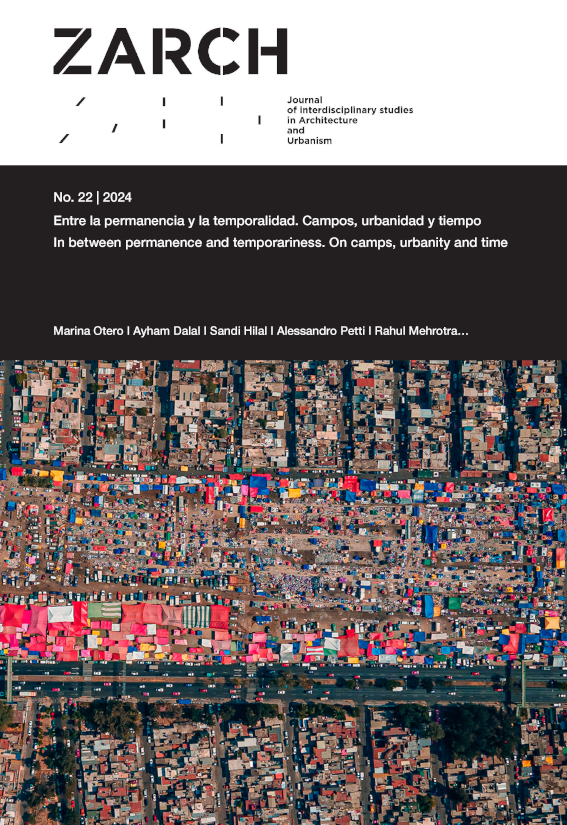The event as architecture. Learning from pop-up urbanisms
DOI:
https://doi.org/10.26754/ojs_zarch/zarch.2024229856Keywords:
Event, Pop-up urbanisms, Festival, Glastonbury, Lollapalooza, Burning ManAbstract
Over the last decades, urban events around ephemeral programs have multiplied and consolidated. Music festivals constitute a perfect example of a typology of urbanism that, equipped with budgets comparable to some more conventional types, generates urbanity and co-constructs our societies from a new metropolitan paradigm which is less dependent on form than on experience. This article will try to develop how the urban Event operates as Architecture. For such a purpose, its historical antecedents will be traced, identifying how the counterculture of the 60s provided a breeding ground for a new ephemeral typology supported by what could be defined as “pop-up urbanisms.” A methodology has been established by which the specific example of Pop Festivals is taken as a materialization of this metropolitan typology. Three types have been identified that, studied through three case studies, define the infrastructural schemes around the relationship of the Event with the territory and the city. Glastonbury, Lollapalooza and Burning Man will be analyzed to extract the particular characteristics of each type. Finally, the general conditions that define this typology with an expiration date will be stated. A typology in which “architectural form” corresponds to the “performance of the event.”
Downloads
References
Archigram Group. Archigram. (New York: Princeton Architectural Press, 1999).
Balamir, Selçuk. More Than Dust: The Burning Man Festival. Reading Concepts of Intermediality, Ginette Verstraete, Sven Lütticken. (Amsterdam: Design Cultures, 2011).
Bennett, Andy; Taylor, Jodie; Woodward, Ian. The Festivalization of Culture. (London: Routledge, 2014).
Bourriaud, Nicolas. The Radicant. Nueva York: Sternberg Press, 2009.
Cook, Peter. Archigram Magazine, n. 7. (London: Archigram Group, 1967).
Cook, Peter. “Back to the Future: The Architecture of Entertainment“ , Architectural design, Vol. 91, 6. (Chichester: John Wiley & Sons, 2021).
Cummings, Joanne; Herbon, Jacinta. “Festival Bodies: the corporeality of the contemporary festival scene in Australia.“ en The Pop Festival. George McKay (ed.) (London: Bloomsbury, 2015).
Duffy, M. “The Emotional Ecologies of Festivals“ en The Festivalization of Everyday Life: Identity, Culture and Politics -Giorgi, Sassatelli, Delanty (eds.) (Ashgate: Farnham, 2014).
Dylan, Bob. “Mr. Tambourine Man“ en Bringing it all Back Home. (New York: Columbia Records, 1965).
Foucault, Michael. Dits et écrits, vol. III. (Paris: Gallimard, 2001).
Giorgi, L.; Sassatelli, M; Introduction. En Festivals and the Cultural Public Sphere. Giorgi, Sassatelli y Delanty (eds.) (New York, London: Routledge, 2011).
Gavin Grindon, Gavin. Revolutionary Romanticism: Henri Lefebvre’s Revolution-as-Festival. Third Text, (London: Routledge, 2013).
Huizinga, Johan. Homo Ludens. (Madrid: Alianza, 2012).
James, Jerry. “In the Beginning“ en Playa Dust: Collected Stories from Burning Man, Samantha Krukowski (ed). (London: Black Dog, 2014).
Khomami, Nadia. Glastonbury tickets take over an hour to sell out after ‘technical problem. En The Guardian, 6 Noviembre 2022
Lachno, James. Glastonbury 2013: Glastonbury through the years, Telegraph, Julio 2013
Lefebvre, Henri. Critique of Everyday Life. London: Verso, 1991
McKay, George. The Pop Festival. History, music, media culture. Introduction. London: Bloomsbury, 2015
Medina Gavilanes, Ana Gabriela. Radical spatiality: dissident architectural practices in contemporary occupations. Tesis doctoral. E.T.S. Arquitectura, UPM, 2017
Metcalf, Bill. Alternative and Comunal Australia?. En ‘Introduction’. The Pop Festival, George McKay. London: Bloomsbury, 2015
Moore, Stephan; Scott Smallwood, Scott. The Soundscape of Burning Man, Soundscape Journal vol. 11, 2011
Neal, Peter; Roeg, Nicolas. Glastonbury Fayre, Documental audiovisual, 1971
O’Grady, Alice. Alternative Playworlds: Psytrance festivals, deep play and creative zones of transcendence. En The Pop Festival, Ed. George McKay. London: Bloomsbury, 2015
Pope, Janey. Lollapalooza 2008. NME. 14 Agosto 2008
Reality Check team, Music festivals: What’s the world’s biggest?, BBC News, 4 Julio 2018
Roche, M. Festivalization, Cosmopolitanism and European Culture. En Festivals and the Cultural Public Sphere, Giorgi, Sassatelli y Delanty eds. New York - Routledge, 2011
Scott Brown, Denise; Venturi, Robert; Izenour Steven. Aprendiendo de las Vegas: el simbolismo olvidado de la forma arquitectónica. Barcelona: Gustavo Gili, 1978
Scruggs, Greg. Building a City at Burning Man, Next American City, 30 Agosto 2010
St John, Graham. Post-rave Techno-tribalism and the carnival of protest. En The Post-Subcultures Reader, David Muggleton and Rupert Weinzierl Eds. London: Berg, 2003
St John, Graham. Global Tribe: Technology, Spirituality and Psytrance. Sheffield: Equinox, 2012
Tremethick, Rewan. Money Facts from the World’s Largest Festival, TorFX, 23 Junio 2016
Tschumi, Bernard. The Manhattan Transcripts. New York, 1976-1981
Who; The. Baba O’Riley. Who’s Next?. Londres: Olympic, 1971


